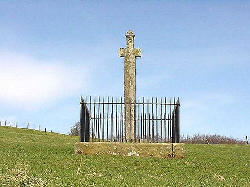 |
Description: On the shaft of Millholm Cross is carved a sword with the initials MA and AA above. The cross probably commemorates Alexander Armstrong, laird of nearby Mangerton Tower and one of the no...
Type: Archaeological-Sites
|
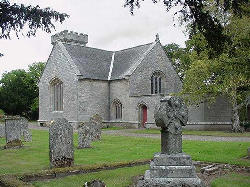 |
Description: Minto is a planned village designed and laid out by William Playfair for the 2nd Earl of Minto. The Church, built as part of the plan, was completed in 1831 and replaced a much earlier ...
Type: Archaeological-Sites
|
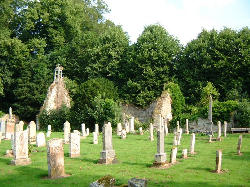 |
Description: Virtually no trace remains of the original church recorded in 1116 AD. The now ruined building which was built in the 18th century is outside the present village. Repaired in 1832, but ...
Type: Archaeological-Sites
|
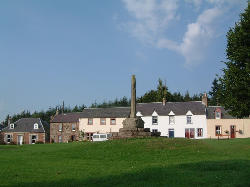 |
Description: A carved stone cross stands on the triangular village green, where regular markets took place from 1490. Bishop Blackadder of Glasgow, as feudal lord of the village, set up a market in a...
Type: Archaeological-Sites
|
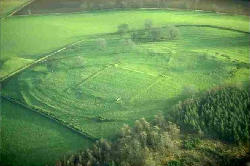 |
Description: Looking over the present town of Duns, a path leads from Castle Street to the top of this hill, site of the first town. The hill is crowned by the defensive banks of an Iron Age settleme...
Type: Archaeological-Sites
|
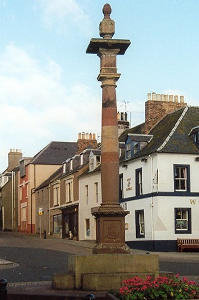 |
Description: Duns was granted the status of a Burgh of Barony in 1490 by King James IV in favour of George Hume of Ayton and his son, John. The Market Cross was a symbol of the town's commercial ...
Type: Archaeological-Sites
|
|
Description: Dykescroft Information Centre houses an exhibition of forestry past and present and leads to Priest Hill, where there are the remains of a 2000 year old Iron Age hillfort and the sites of...
Type: Archaeological-Sites
|
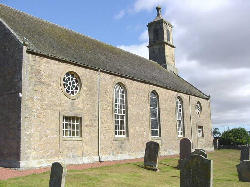 |
Description: The mediaeval church dedicated to St Andrew was replaced by the present building in 1774. The western boundary walls of the kirkyard include parts of the Convent Church of St Mary the ...
Type: Archaeological-Sites
|
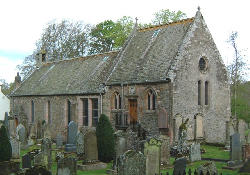 |
Description: The monks of Kelso Abbey founded the church at Bowden around 1128, although only some fragments in the west gable and north wall survive from this original structure. The original chur...
Type: Archaeological-Sites
|
|
Description: In the 12th century, the village of Castleton consisted of the parish church, the houses of the villagers and the earth and timber castle of the Norman family of Soules. Little of this n...
Type: Archaeological-Sites
|
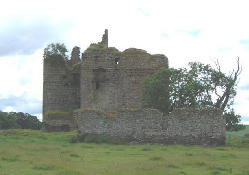 |
Description: Built about 1450 for Andrew Ker, the ruins of this castle remind one of the turbulent times during the 16th century when the Border area was the scene of continuing warfare between the S...
Type: Archaeological-Sites
|
|
Description: Remains of the Norman parish church of Chirnside can still be seen as a blocked window in the lower part of the western tower and as an ornamental doorway through the south wall. Sundi...
Type: Archaeological-Sites
|
 |
Description: Probably erected about 1612, when King James VI granted the village status as a Burgh of barony, although local tradition states that it is older, having been erected to commemorate the...
Type: Archaeological-Sites
|
|
Description: Cockburnspath Church was originally a dependant chapel of Coldingham Priory. The current building was extensively rebuilt after the ravages which followed its original construction in ...
Type: Archaeological-Sites
|
|
Description: Founded in the early 12th century by monks from the Benedictine Monastery at Durham it was attcked frequently over the centuries with Cromwell leaving it a smoking ruin in 1648 as he mo...
Type: Archaeological-Sites
|
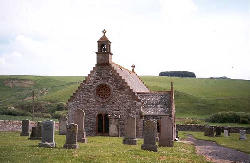 |
Description: The present church dates only from 1899, built on the site of at least two previous buildings. The original church was severely neglected after the Reformation, and a new building was e...
Type: Archaeological-Sites
|
|
Description: Standing by the roadside, this cross was erected so that travellers would know that they were approaching the boundary of Eccles Nunnery, a Cistercian Nunnery. This priory was in existen...
Type: Archaeological-Sites
|
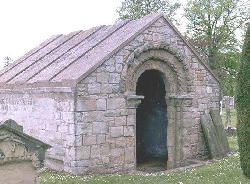 |
Description: Very highly carved Romanesque doorway, dating from the 12th century; formerly the door to the church, Now the entrance to a burial vault in the graveyard. Ownership: In the care o...
Type: Archaeological-Sites
|
|
Description: This promontory was fortified in 1547 by invading English troops and again in 1557 by French forces acting on behalf of the Scottish king. The two lines of ramparts, with bastions and ...
Type: Archaeological-Sites
|
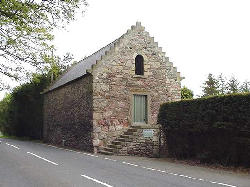 |
Description: A two-storey barn which was used for storing the grain which was the tithe or teind (tenth part) payable to the church. Ownership: In the care of Historic Scotland Situation: OS...
Type: Archaeological-Sites
|
 |
Description: Dating from 2nd century, one of a very limited number of Iron Age brochs in the lowlands of Scotland. It sits within an earlier fort which is surrounded by ramparts and ditches. Later,...
Type: Archaeological-Sites
|
|
Description: Lying between Jedburgh and Hawick, these are the remains of a 16th century tower house. It was held by Margaret Home of Cowdenknowes prior to her wedding to William Turnbull of Bedrule. ...
Type: Archaeological-Sites
|
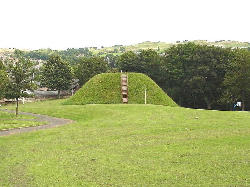 |
Description: Standing in Motte Park are the remains of this �motte and bailey� castle which was the stronghold of the Lovell family. All that now remains are the remnants of the main earthen mound...
Type: Archaeological-Sites
|
|
Description: Remains of a 13th or 14th century chapel and graveyard are enclosed within the defensive earthworks of an earlier farmstead. A low mound known as the "Cout o' Kielder's Gr...
Type: Archaeological-Sites
|
|
Description: The site of the skirmish in 1514 when, according to local tradition, a group of English marauders were put to flight by a group of young men from Hawick. The Hawick Cornet, who leads th...
Type: Archaeological-Sites
|
|
Description: The most complete Roman fort in Britain, extensively excavated, with the finds displayed in the museum amd visitor centre. Ownership: National Trust and English Heritage with Trust ...
Type: Archaeological-Sites
|
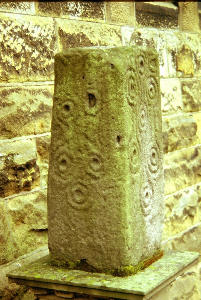 |
Description: Standing outside the east end of the church is an ancient carved stone. Thought to be the base of a preaching cross dating from the 9th century, it came from the foundations of the prev...
Type: Archaeological-Sites
|
|
Description: The foundations of the last monastic house to be founded in Scotland are visible in this garden. Many medicinal herbs and local varieties of fruit tree are to be found here. Interpretat...
Type: Archaeological-Sites
|
|
Description: Johnnie Armstrong of Gilnockie was an infamous reiver who was a thorn in the side of the Scottish King James V. No matter what the King did, Armstrong went his own way and did his own t...
Type: Archaeological-Sites
|
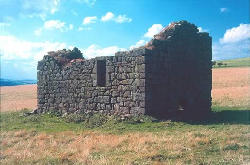 |
Description: A good example of a 16th century bastle house, or fortified farmhouse, which provided shelter from the cross-border reivers or raiders in the days before peace reigned between Scotland an...
Type: Archaeological-Sites
|
|
Description: The Church of St Bride was part of the Diocese of Glasgow, based in Strathclyde and which paid particular honour to saints from the celtic nations � Scotland, Wales and Ireland. First r...
Type: Archaeological-Sites
|
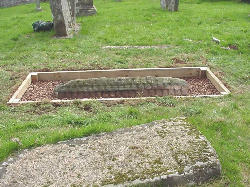 |
Description: The site of the former 13th century parish church can still be made out as a turf-covered two cell structure close to the centre of the churchyard. The smaller of the two cells represen...
Type: Archaeological-Sites
|
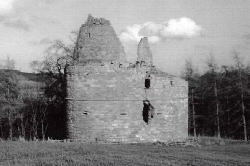 |
Description: Littledean Tower, near Ploughlands Farm, was formerly a very important defended house, for many years the home of the Kers of Littledean, a branch of the Kers of Cessford. It makes use ...
Type: Archaeological-Sites
|
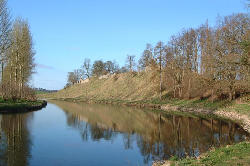 |
Description: The ruins of the famous castle of Roxburgh, favourite of Scottish kings, seated on its massive grassy mound between the Rivers Tweed and Teviot. Ownership: On Roxburghe Estates la...
Type: Archaeological-Sites
|
|
Description: The Market Square was the most important part of the mediaeval town. There the commercial activity was based, with the various separate markets taking place close by. The Pant Well was ...
Type: Archaeological-Sites
|
|
Description: An area of water meadow across which runs the Southern Upland Way. This site saw a battle in July 1526, when Sir Walter Scott of Branxholm tried unsuccessfully to rescue the young King...
Type: Archaeological-Sites
|
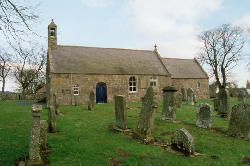 |
Description: Founded by David de Olifard in the 12th century and subsequently granted to the Benedictine monks of Coldingham priory. The exterior still shows much of the original stonework, particu...
Type: Archaeological-Sites
|
 |
Description: The most important Roman military complex between Hadrian's Wall and the Antonine Wall guarded and secured the crossing of the Tweed at Newstead in the 2nd century AD. Excavations ha...
Type: Archaeological-Sites
|
|
Description: An early Christian stone from the 5th Century AD, which commemorates the burial site of two Christian princes � Nudos and Dumnogenos, sons of Liberalis. Ownership: On private ground....
Type: Archaeological-Sites
|
|
Description: The ruins of the medieval church of "Zedon" where, in 1388, Scottish nobles planned an invasion of England watched by an English spy. The spy gave himself away, but bought his ...
Type: Archaeological-Sites
|
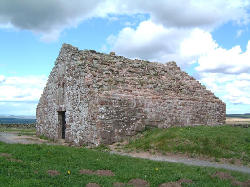 |
Description: Midway between Edinburgh and the magnificent Border abbeys from the 12th to the 17th century stood a mediaeval hospital � a refuge for travellers and the needy on the Royal Road, the ma...
Type: Archaeological-Sites
|
|
Description: Although the original village dates back to the 11th century, the present village was laid out as a planned village in the 18th century. The market cross stands on the Village Green wher...
Type: Archaeological-Sites
|
 |
Description: The summit of Eildon North Hill is crowned by the largest hillfort in Scotland. Built in the 10th century BC, this fortified site contains platforms for nearly 300 huts and may have se...
Type: Archaeological-Sites
|
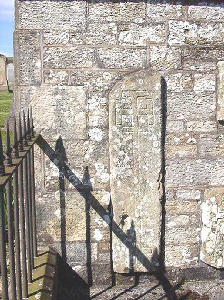 |
Description: No trace survives of the mediaeval church which served the parish of Ettleton until 1604, except for the collection of carved stones set into the graveyard wall. Amongst these are seve...
Type: Archaeological-Sites
|
|
Description: First recorded in 1423 as the �New Werk� to replace the �Oldworck�. Attacked twice during the 16th century, it was eventually destroyed by Cromwell�s forces in 1650. In the 18th centur...
Type: Archaeological-Sites
|
|
Description: This village was planned from scratch by the 3rd Duke of Buccleuch. At this time in the 18th century, Castleton was a series of scattered farms with a church. The Duke's aim was to ...
Type: Archaeological-Sites
|
|
Description: A small stone circle erected between 5000 and 4000 years ago, as a place of ceremonial worship and perhaps burial. Lord Soules of Hermitage Castle is said to have been wrapped in lead an...
Type: Archaeological-Sites
|
 |
Description: A 150 foot tower, built between 1817 and 1824 to commemorate the Battle of Waterloo, standing on a hill top near to Harestanes Visitor Centre. The tower itself is NOT open to the public....
Type: Archaeological-Sites
|
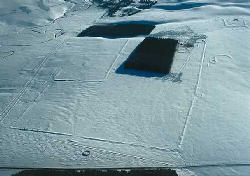 |
Description: At Pennymuir the ramparts and entrances of two marching camps are particularly well preserved. Close to what is now the border, they are a reminder of the many occasions on which Roman l...
Type: Archaeological-Sites
|
|
Description: This hill is crowned by the remains of an iron age hillfort which is marked by the two lines of ramparts and the sites of several circular houses within. This site was the homestead o...
Type: Archaeological-Sites
|
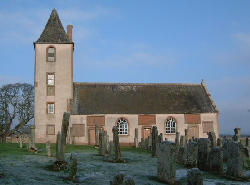 |
Description: Although an inscribed stone set into the south wall claims that there has been a church on this site from before 900AD, this church was built in 1703 and replaced the mediaeval church o...
Type: Archaeological-Sites
|
|
Description: This fine bridge dates from 1770 and was an important element of the Duns to Grantshouse and Dunbar Turnpike which was opened in the 1840's. Today there are fine views along the Ri...
Type: Archaeological-Sites
|
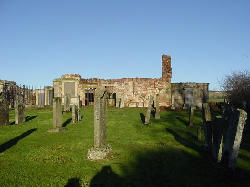 |
Description: The first Preston Church was built in the 12th century and belonged to the Bishopric of Dunkeld. Stones from this period with Norman carving were incorporated into the present church whi...
Type: Archaeological-Sites
|



